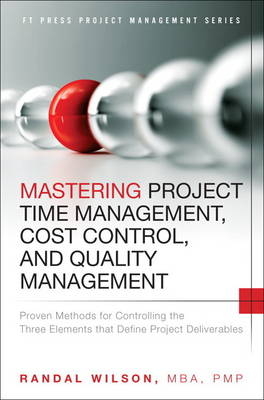
Mastering Project Time Management, Cost Control, and Quality Management
Pearson FT Press (Verlag)
978-0-13-383975-3 (ISBN)
- Titel ist leider vergriffen;
keine Neuauflage - Artikel merken
This book is part of a new series of seven cutting-edge project management guides for both working practitioners and students. Like all books in this series, it offers deep practical insight into the successful design, management, and control of complex modern projects. Using real case studies and proven applications, expert authors show how multiple functions and disciplines can and must be integrated to achieve a successful outcome.
Individually, these books focus on realistic, actionable solutions, not theory. Together, they provide comprehensive guidance for working project managers at all levels, including highly-complex enterprise environments. These books also provide indispensable knowledge for anyone pursuing PMI/PMBOK or PRINCE2 certification, or other accreditation in the field.
Randal Wilson, MBA, PMP, serves as Visiting Professor of Project Management, Keller Graduate School of Management, at the Elk Grove, California DeVry University campus. His teaching style addresses Project Management concepts using not only academic course guidelines and text, but includes in-depth discussions in lectures using practical application from industry experience. Mr. Wilson is currently Operations and Project Manager at Parker Hose and Fittings. He is responsible for five locations across Northern California and Nevada, as well as project management of redesigns and renovation of existing facilities and construction of new facilities. Mr. Wilson was formally in the telecommunications industry as Senior New Product Introduction Engineer at REMEC, Inc., Senior New Product Introduction Engineer with Spectrian Corp., and Associate Design Engineer with American Microwave Technology. He also served as Senior Manufacturing Engineer at Hewlett Packard. He is a certified Project Management Professional (PMP) of the Project Management Institute. He acquired an MBA with concentration in General Operations Management from Keller Graduate School of Management of DeVry University and a Bachelor of Science in Technical Management with concentration in Project Management from DeVry University in Fremont, California.
Introduction 1
The Triple Constraint 2
Managing Change Requirements 4
Managing Time, Cost, and Quality 7
Managing Project and Product Scope 7
Time Management 8
Cost Management 9
Quality Management 9
What Does the Customer Really Want? 10
Part I: Project Time Management 13
Chapter 1 Planning Schedule Management 15
1.1 Introduction 15
1.2 Tools for Schedule Management Planning 16
Minimum Requirements 17
Plan Structures 18
Project Management Office (PMO) 23
1.3 Information Gathering for the Schedule Management Plan 24
Project Charter 24
Project Manager’s Experience 25
Organizational Past Projects 26
Subject Matter Experts 27
1.4 Schedule Management Plan Applications 28
Tactical Tool for Project Managers 28
Communications Tool for the Project Staff 29
Strategic Tool for the Organization 30
1.5 Summary 31
1.6 Review Questions 33
1.7 Key Terms 34
1.8 PMBOK Connections (Fifth Edition) 35
1.9 Case Study (Use for Part I, Chapters 1–7) 35
RE Construction—Custom Pebble Beach Home 35
1.10 Case Study Questions and Exercise 37
Questions 37
Exercise 38
Chapter 2 Project Activity Requirements 39
2.1 Introduction 39
2.2 Information-Gathering Guidelines 40
What Information Is to Be Gathered? 41
Who Is Gathering Information? 42
Reliability of Information 44
Information Accuracy 49
Information Sources 50
2.3 Activity Information Based on Project Structure 51
Linear (Traditional Sequential Process Development) 52
Incremental (Traditional Progressive Stage Development) 53
Iterative (Features Addition Development, Waterfall, Agile) 55
Adaptive (Learn and Build Development, Agile) 58
Extreme (Exploratory Development) 59
2.4 Define Activities 62
Project Deliverable Decomposition 63
Define Activity Requirements 65
Work Breakdown Structure (WBS) 68
2.5 Summary 71
2.6 Review Questions 72
2.7 Key Terms 73
2.8 PMBOK Connections (Fifth Edition) 73
2.9 Case Study Questions and Exercises (Use Case Study from Chapter 1) 74
Questions 74
Exercises 74
Chapter 3 Project Activity Sequencing 75
3.1 Introduction 75
3.2 Work Activity Definition 77
Conceptual Planning 77
Project Development 80
Testing and Validation 80
Reactive and Proactive Response 82
Customer/Project Team Evaluation 84
Project Closure 85
3.3 Work Activity Dependencies 87
Activity Information 88
Dependency Determination 94
3.4 Work Activity Sequencing Tools 96
Precedence Diagramming Method 97
3.5 Summary 108
3.6 Review Questions 109
3.7 Key Terms 110
3.8 PMBOK Connections (5th Ed.) 111
3.9 Case Study Questions and Exercises (Use Case Study from Chapter 1) 111
Questions 111
Exercises 111
Chapter 4 Resource Estimating 113
4.1 Introduction 113
4.2 Types of Resources 116
Direct and Indirect Resources 117
Project Resources 118
Contracted Resources 121
4.3 Resource Requirements 122
Organizational Resources 123
Project Resources 124
4.4 Resource Estimating Methods 128
Determinate Estimating 128
Alternatives Analysis 129
Delphi Method 129
Published Data Estimating 129
Resource Leveling 130
4.5 Resource Estimating by Project Structure 132
Linear and Incremental 132
Iterative and Adaptive 133
Extreme 134
4.6 Summary 135
4.7 Review Questions 136
4.8 Key Terms 137
4.9 PMBOK Connections (5th Ed.) 137
4.10 Case Study Questions and Exercise (Use Case Study from Chapter 1) 138
Questions 138
Exercise 138
Chapter 5 Project Activity Duration Analysis 139
5.1 Introduction 139
5.2 Duration Estimating Methods 140
Subject Matter Expert Estimating (Delphi) 140
Analogous Estimating 142
Parametric Estimating 143
Three-Point Estimating 144
Contingency Estimating (Reserve Analysis) 147
5.3 Summary 149
5.4 Review Questions 150
5.5 Key Terms 150
5.6 PMBOK Connections (Fifth Edition) 151
5.7 Case Study Questions and Exercise (Use Case Study from Chapter 1) 151
Questions 151
Exercise 151
Chapter 6 Develop the Project Schedule 153
6.1 Introduction 153
6.2 Information for Schedule Development 154
Project Charter 155
Project Deliverable Specifications 155
Work Breakdown Structure 156
Activity Information Checklist 156
Project Scope Statement 157
Organizational Influences 157
Customer Scheduling Requirements 159
External Factors 160
6.3 Schedule Structuring Techniques 161
Activity Disposition 162
Activity Hierarchy 163
Critical Path Method 164
Theory of Constraints 166
Critical Chain Method 167
Resource Loading 169
Scenario Analysis 171
6.4 Schedule Documentation Tools 173
Software Tools 173
Schedule Management 175
Schedule Communication 176
6.5 Summary 177
6.6 Review Questions 178
6.7 Key Terms 178
6.8 PMBOK Connections (5th Ed.) 179
6.9 Case Study Questions and Exercise (Use Case Study from Chapter 1) 179
Questions 179
Exercise 180
Chapter 7 Control Project Schedule 181
7.1 Introduction 181
7.2 Schedule Control Information 183
Schedule Baseline 183
Work Activity Monitoring 185
Earned Value Analysis 187
Milestone Analysis 192
7.3 Schedule Control Techniques 192
Contingency Control 193
Schedule Crashing 193
Resource Contracts 194
Change Control 195
Verify Control 196
7.4 Summary 197
7.5 Review Questions 199
7.6 Key Terms 199
7.7 PMBOK Connections (5th Ed.) 200
7.8 Case Study Questions and Exercise (Use Case Study from Chapter 1) 200
Questions 200
Exercise 200
Part II: Project Cost Management 201
Chapter 8 Plan Cost Management 203
8.1 Introduction 203
8.2 Information for Planning Costs 205
Cost Definitions 205
Project Charter 209
Statement of Work 209
Project Manager’s Experience 210
Subject Matter Experts 210
Project Structures 211
8.3 Develop the Cost Management Plan 211
Components of the Plan 212
8.4 Cost Management Plan Applications 213
Organizational Strategic Planning 214
Tool for Manager’s Tactical Use 214
8.5 Summary 216
8.6 Review Questions 217
8.7 Key Terms 218
8.8 PMBOK Connections (5th Ed.) 218
8.9 Case Study (Use for Part II, Chapters 8–11) 218
Mass Brothers Automotive—IT Infrastructure Upgrade 218
8.10 Case Study Questions and Exercises 220
Questions 220
Exercises 220
Chapter 9 Estimate Project Costs 221
9.1 Introduction 221
9.2 Project Cost Requirements 223
Statement of Work 224
Work Breakdown Structure 224
Activity Information Checklist 225
Scope Statement 226
9.3 Cost Estimating Tools 227
Cost Management Plan 228
Cost Constraints 232
Analogous Cost Estimating 234
Parametric Cost Estimating 234
Rough Order-of-Magnitude Estimating 235
Subject Matter Experts 236
Three-Point Cost Estimating 236
Top-Down and Bottom-Up Estimating 239
Contingency Cost Estimating 240
9.4 Estimating Based on Project Structures 242
Linear and Incremental 242
Iterative and Adaptive 243
Extreme 244
9.5 Summary 245
9.6 Review Questions 246
9.7 Key Terms 247
9.8 PMBOK Connections (5th Ed.) 247
9.9 Case Study Questions and Exercises (Use Case Study from Chapter 8) 248
Questions 248
Exercises 248
Chapter 10 Develop a Project Budget 249
10.1 Introduction 249
10.2 Purpose of a Project Budget 250
Budget at Completion 251
Project Budget Baseline 252
Manage the Triple Constraint 252
Communicate Project Status 254
Organizational Planning 254
10.3 Budget Methods 255
Cost Aggregation Method 256
Time-Phased Method 256
Top-Down Budgeting 257
Analogous Budgeting 259
Funding Limit Reconciliation 260
10.4 Summary 261
10.5 Review Questions 262
10.6 Key Terms 263
10.7 PMBOK Connections (5th Ed.) 263
10.8 Case Study Questions and Exercises (Use Case Study from Chapter 8) 264
Questions 264
Exercises 264
Chapter 11 Control Project Costs 265
11.1 Introduction 265
11.2 Cost Control Data 266
Monitor Costs 267
Cost Analysis Tools 269
11.3 Cost Control Techniques 272
Integrated Change Control 272
Contingency Control 273
Contract Control 274
Procurement Review and Approval 276
Control Verification 276
11.4 Summary 277
11.5 Review Questions 279
11.6 Key Terms 280
11.7 PMBOK Connections (5th Ed.) 280
11.8 Case Study Questions and Exercises (Use Case Study from Chapter 8) 281
Questions 281
Exercises 281
Part III: Project Quality Management 283
Chapter 12 Plan Quality Management 285
12.1 Introduction 285
12.2 Components of a Quality Management Plan 286
Establish Quality Monitoring 287
Determine Analysis Methodologies 288
Establish Quality Metrics 288
Plan Quality Assurance 289
Determine Cost of Quality 289
Integrate a Change Control Process 290
Determine Quality Controls 290
12.3 Tools for Quality Management Planning 291
Statistical Sampling 291
Design of Experiments 292
Benchmarking 292
Subject Matter Expert Meetings 293
Brainstorming 294
12.4 Summary 294
12.5 Review Questions 295
12.6 Key Terms 296
12.7 PMBOK Connections (5th Ed.) 296
12.8 Case Study (Use for Part III, Chapters 12–14) 297
Lewton Telecom—Engineering Prototype Project 297
12.9 Case Study Questions and Exercises 298
Questions 298
Exercises 299
Chapter 13 Conduct Quality Assurance 301
13.1 Introduction 301
13.2 Project Quality Assurance Data 302
Quality Management Plan 303
Organizational Quality Standards 303
Industry Quality Standards 305
Customer Quality Standards 305
Quality Metric 307
13.3 Quality Assurance Tools 307
Quality Audits 308
Process Analysis 308
13.4 Quality Assurance Results 312
Continuous Improvement 313
Process Capability 313
Change Requests 313
13.5 Summary 314
13.6 Review Questions 315
13.7 Key Terms 316
13.8 PMBOK Connections (5th Ed.) 316
13.9 Case Study Questions and Exercises (Use Case Study from Chapter 12) 316
Questions 316
Exercises 317
Chapter 14 Control Project Quality 319
14.1 Introduction 319
14.2 Establish What to Control 320
Statement of Work 321
Customer Specifications 321
Workmanship Performance Reports 322
Organizational Requirements 323
Project Risk Register 324
14.3 Quality Control Tools and Techniques 324
Inspections 325
Statistical Sampling 326
Design Review 327
Seven Basic Quality Tools 328
14.4 QC Results 334
Quality Improvements 335
Updates to Project Schedule and Budget 335
Verification of Deliverable Quality 336
Project Process Updates 336
Organizational Process Updates 337
14.5 Summary 337
14.6 Review Questions 340
14.7 Key Terms 340
14.8 PMBOK Connections (5th Ed.) 341
14.9 Case Study Questions and Exercises (Use Case Study from Chapter 12) 341
Questions 341
Exercises 341
Appendix A Change Control Process 343
Bibliography 347
Index 349
The definitive guide to managing the "triple constraint" of time, cost, and quality in any project
| Erscheint lt. Verlag | 18.5.2015 |
|---|---|
| Verlagsort | NJ |
| Sprache | englisch |
| Maße | 152 x 229 mm |
| Gewicht | 662 g |
| Themenwelt | Technik ► Elektrotechnik / Energietechnik |
| Technik ► Maschinenbau | |
| Wirtschaft ► Betriebswirtschaft / Management ► Controlling / Kostenrechnung | |
| Wirtschaft ► Betriebswirtschaft / Management ► Logistik / Produktion | |
| Wirtschaft ► Betriebswirtschaft / Management ► Projektmanagement | |
| Wirtschaft ► Betriebswirtschaft / Management ► Unternehmensführung / Management | |
| ISBN-10 | 0-13-383975-3 / 0133839753 |
| ISBN-13 | 978-0-13-383975-3 / 9780133839753 |
| Zustand | Neuware |
| Informationen gemäß Produktsicherheitsverordnung (GPSR) | |
| Haben Sie eine Frage zum Produkt? |
aus dem Bereich


